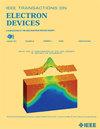Suppressing the Multipactor in Microwave Devices by Introducing the Dielectric Material
IF 3.2
2区 工程技术
Q2 ENGINEERING, ELECTRICAL & ELECTRONIC
引用次数: 0
Abstract
This study proposes a method for suppressing the multipactor effect in high-power microwave devices for spacecraft applications by integrating dielectric materials. Electromagnetic fields are numerically analyzed using the CST Microwave Studio, while multipactor thresholds are accurately predicted via an in-house developed 3-D particle-in-cell (PIC) simulation code. A systematic investigation is conducted to examine how the geometric parameters and material properties of dielectric influence multipactor. Simulation results show that when the dielectric width matches that of a parallel-plate or rectangular waveguide, increasing both the thickness and relative permittivity enhances the amplitude of the radio frequency (RF) electric field, accompanied by a decrease in the multipactor threshold. Conversely, when the dielectric width is smaller than the waveguide, the RF electric field amplitude decreases, leading to an increase in the multipactor threshold. Notably, partially filled dielectric can reduce the RF electric field amplitude by up to 90%, and improve the threshold by as much as 40 times compared to unfilled dielectric. These findings provide critical design insights for high-power microwave components in space applications.引入介电材料抑制微波器件中的多因子
本研究提出了一种集成介质材料抑制航天器用高功率微波器件多因子效应的方法。使用CST Microwave Studio对电磁场进行数值分析,同时通过内部开发的三维粒子池(PIC)模拟代码准确预测多因子阈值。系统地研究了介电介质的几何参数和材料特性对多因子的影响。仿真结果表明,当介质宽度与平行板波导或矩形波导相匹配时,增加介质厚度和相对介电常数可以提高射频电场的幅值,同时降低多因子阈值。相反,当介质宽度小于波导时,射频电场振幅减小,导致多因子阈值增加。值得注意的是,与未填充的介质相比,部分填充的介质可以将射频电场振幅降低高达90%,并将阈值提高多达40倍。这些发现为空间应用中的高功率微波元件提供了关键的设计见解。
本文章由计算机程序翻译,如有差异,请以英文原文为准。
求助全文
约1分钟内获得全文
求助全文
来源期刊

IEEE Transactions on Electron Devices
工程技术-工程:电子与电气
CiteScore
5.80
自引率
16.10%
发文量
937
审稿时长
3.8 months
期刊介绍:
IEEE Transactions on Electron Devices publishes original and significant contributions relating to the theory, modeling, design, performance and reliability of electron and ion integrated circuit devices and interconnects, involving insulators, metals, organic materials, micro-plasmas, semiconductors, quantum-effect structures, vacuum devices, and emerging materials with applications in bioelectronics, biomedical electronics, computation, communications, displays, microelectromechanics, imaging, micro-actuators, nanoelectronics, optoelectronics, photovoltaics, power ICs and micro-sensors. Tutorial and review papers on these subjects are also published and occasional special issues appear to present a collection of papers which treat particular areas in more depth and breadth.
 求助内容:
求助内容: 应助结果提醒方式:
应助结果提醒方式:


